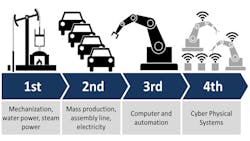What Is Hannover Messe Fair and How Does It Play a Role in the US?
The Internet of Things (IoT) is a growing facet of the engineering industry and is poised to become part of not only the engineering industry, but also infiltrate all other technology of our everyday lives. There are several terms used to describe the Internet of Things, but one of the most common is “Industry 4.0.”
Industry 4.0 (or Industrie 4.0) comes from Germany. The term was first used at the Hannover Messe Fair in 2011 and is meant to describe the next wave of industrial revolution. The first industrial revolution introduced mobilized mechanical production using water and steam power at the end of 18th century. The second industrial revolution brought the division of labor mass production via electrical energy around the turn of the 20th century. This type of production is illustrated best by the assembly line used by Henry Ford. The third industrial revolution integrated electronics and IT technology into production. The fourth industrial revolution is bringing digital processing into the production process. This involves wireless communication between devices, wireless sensing and data reports, and modeling and simulation of physical models to make decentralized decisions.
Hannover Messe Fair is one of the largest expositions to showcase the latest developments of IoT. The show is expected to have more than 5,000 exhibitors from 60 countries and more than 200,000 visitors from 100 different countries. These companies will be highlighting the latest and greatest innovations related to future factory, energy solutions, and IoT. And a first for Hannover this year is that the United States is the invited Partner Country. The U.S. is the world’s biggest nation economy, accounting for 25% of the global economy. In recent years, the U.S. has made great strides to compete in the IoT field and implement its technological advancements. The term “smart manufacturing” has come to categorize IoT in the United States. Ethernet cables, human machine interfaces, and wireless communications are now being used in automation and to construct smart cities and factories.
As someone constantly engaged in the developments of IoT, I look forward to what U.S. participation will bring to Hannover. The U.S. Investment Pavilion will have more than 350 exhibitors from the United States alone. IoT will create an interconnected world of devices, and international shows like Hannover are important to help develop and stabilize standards that all companies can follow. Our production is not restricted to one country. Products designed in California are built in China or modern drives and PLCs are made in Germany and operated in the U.S. The world of IoT helps advance the communication between these different industries, which will lead to faster and more efficient production. If these standards are developed independently of one another, trying to advance our production line on our own will become a much larger struggle. Stay tuned to our site and follow me online for updates from the show.
